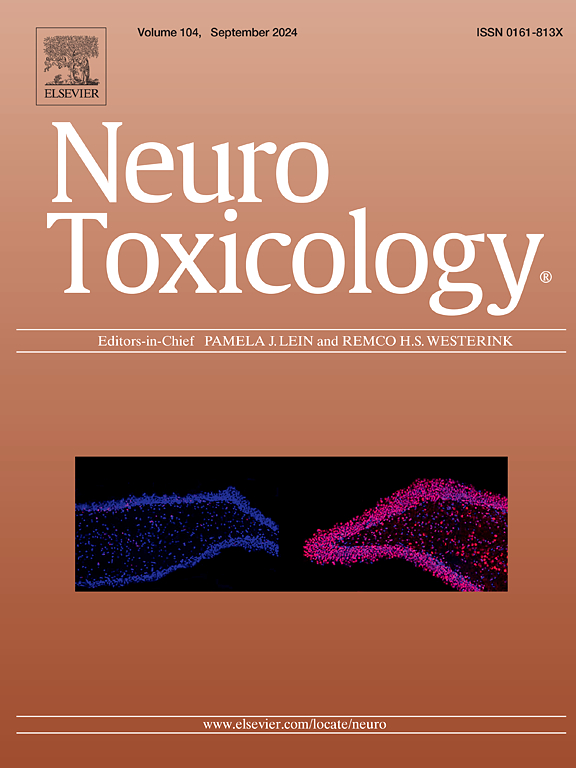Prenatal and early childhood exposure to phthalates and neurodevelopment in 42 months old children
IF 3.9
3区 医学
Q2 NEUROSCIENCES
引用次数: 0
Abstract
Background
Increased prevalence of neurodevelopmental syndromes raises concerns regarding risks from environmental exposures. Phthalates are a class of chemicals widely used in daily products. It has been suggested that prenatal and early childhood exposure to phthalates are associated with disruption of developmental outcomes, cognitive and psychomotor functions.
Aims
To estimate the association between prenatal and early childhood exposure to phthalates and neurodevelopmental outcomes.
Methods
Women were recruited at 11–18 weeks of gestation and provided spot urine samples, analyzed for phthalate metabolites (DEHP, DiNP, MBzBP). Children (n = 102) were examined at 42 months of age, using a broad developmental assessment and standard maternal reports, regarding cognitive, developmental and behavioral problems (WPPSI-III, NIH-toolbox, NEPSY-II, CBCL, ASQ-3 questionnaires), and provided spot urine samples (n = 47). To explore the associations between tertiles or continuous levels of metabolites and developmental outcomes, multivariate general linear models (GLM) were used.
Results
DEHP and DiNP metabolites were above the level of detection (>LOD) in more than 97 % of maternal specimens and MBzBP was detected in 88 % of maternal specimens. Increased DEHP levels were associated with problem solving scores among boys (scores: 53.24 + 2.34, 54.29 + 2.45, and 43.54 + 3.26 for low, medium and high DEHP tertiles, respectively; p = 0.029), and fine motor problems (47.58 + 2.93, 49.75 + 3.07, and 32.01 + 4.07 for low, medium and high DEHP tertiles, respectively; p = 0.003) and attention problems among girls (Flanker scores: 112.53 + 14.28, 110.3 + 12.93, and 98.83 + 12.65 for low, medium and high DEHP tertiles, respectively; p = 0.007). Moreover, in girls, a potential U-shaped association was found between levels of exposure to MBzBP and problem solving (54.55 + 6.87, 44.69 + 14.88, and 54.62 + 6.60 for low, medium and high MBzBP tertiles, respectively; p = 0.015), fine motor problems (56.36 + 5.04, 42.50 + 15.49, and 51.92 + 8.04 for low, medium and high MBzBP tertiles, respectively; p = 0.007), and verbal abilities (Vocabulary scores: 11.46 + 3.01, 8.25 + 3.43, and 11.53 + 2.69 for low, medium and high MBzBP tertiles, respectively; p = 0.007). Early childhood exposure was associated with fine motor scores and DEHP and MBzBP postnatal exposure (DEHP: β = −0.010, Cl: −0.016, −0.004, p = 0.003; MBzBP: β = −0.321, Cl: −0.499, −0.144, p = 0.001). Most associations became nonsignificant after FDR correction for multiple comparisons.
Conclusion
This study suggests associations between prenatal exposure to phthalates and early childhood motor and cognitive abilities, with sex differences, and an association between early childhood exposure with motor abilities. Larger studies are needed to confirm these exploratory findings.
产前和儿童早期接触邻苯二甲酸盐与42个月大儿童的神经发育
背景:神经发育综合征患病率的增加引起了人们对环境暴露风险的关注。邻苯二甲酸盐是一类广泛用于日常用品的化学品。有研究表明,产前和儿童早期接触邻苯二甲酸盐与发育结果、认知和精神运动功能的破坏有关。目的评估产前和儿童早期接触邻苯二甲酸盐与神经发育结局之间的关系。方法在妊娠11-18周招募妇女,提供尿样,分析邻苯二甲酸酯代谢物(DEHP, DiNP, MBzBP)。儿童( = 102)在42月龄时接受检查,使用广泛的发育评估和标准的母亲报告,关于认知、发育和行为问题(WPPSI-III, nih工具箱,nepsyi - ii, CBCL, ASQ-3问卷),并提供尿样( = 47)。为了探索代谢物连续水平与发育结局之间的关系,使用了多变量一般线性模型(GLM)。结果在97% %以上的产妇标本中检出dehp和DiNP代谢物,88% %的产妇标本中检出MBzBP。DEHP水平升高与男孩的问题解决得分相关(低、中、高DEHP的得分分别为53.24 + 2.34、54.29 + 2.45和43.54 + 3.26;p = 0.029),精细运动问题(低、中、高DEHP分别为47.58 + 2.93、49.75 + 3.07和32.01 + 4.07);p = 0.003)和女孩注意问题(低、中、高DEHP砖的Flanker得分分别为112.53 + 14.28、110.3 + 12.93、98.83 + 12.65; = 0.007页)。此外,在女孩中,MBzBP暴露水平与问题解决能力之间存在潜在的u型关联(低、中、高MBzBP纺织品分别为54.55 + 6.87、44.69 + 14.88和54.62 + 6.60);p = 0.015),精细运动问题(低、中、高MBzBP分别为56.36 + 5.04、42.50 + 15.49、51.92 + 8.04);p = 0.007),以及语言能力(低、中、高MBzBP的词汇得分分别为11.46 + 3.01、8.25 + 3.43、11.53 + 2.69; = 0.007页)。儿童早期暴露与精细运动评分、产后暴露与DEHP和MBzBP相关(DEHP: β = - 0.010, Cl: - 0.016, - 0.004, p = 0.003;MBzBP:β=−0.321,Cl: 0.499−−0.144,p = 0.001)。在FDR校正多重比较后,大多数关联变得不显著。结论本研究提示产前邻苯二甲酸盐暴露与儿童早期运动和认知能力之间存在性别差异,以及儿童早期接触邻苯二甲酸盐与运动能力之间存在关联。需要更大规模的研究来证实这些探索性的发现。
本文章由计算机程序翻译,如有差异,请以英文原文为准。
求助全文
约1分钟内获得全文
求助全文
来源期刊

Neurotoxicology
医学-毒理学
CiteScore
6.80
自引率
5.90%
发文量
161
审稿时长
70 days
期刊介绍:
NeuroToxicology specializes in publishing the best peer-reviewed original research papers dealing with the effects of toxic substances on the nervous system of humans and experimental animals of all ages. The Journal emphasizes papers dealing with the neurotoxic effects of environmentally significant chemical hazards, manufactured drugs and naturally occurring compounds.
 求助内容:
求助内容: 应助结果提醒方式:
应助结果提醒方式:


